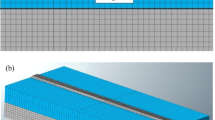Abstract
The bolted connection of a w-beam rail to a guardrail post can have a significant affect on the performance of a guardrail system. For example, if the connections are too strong, the w-beam is likely to be pulled to the ground with the post and result in the vehicle overriding the guardrail. If the connections are too weak, the rail can pull away from the posts too soon allowing the rail to drop and the vehicle to penetrate behind the system. In recent years, finite element simulation has rapidly become a fundamental part of the analysis and design of roadside safety hardware systems, and as such, the finite element models must be capable of accurately simulating the response of these bolted connections. One of the challenges of simulating guardrail collisions is obtaining accurate models of each of the distinct components of the system, such as the various types of bolted connections, and properly modelling their interaction with each other. This study investigates the failure mechanism of the bolted connection of a w-beam rail to a guardrail post using laboratory experiments and uses that information to develop computationally efficient and accurate finite element models of the rail-to-post connection that can be used in routine analysis of guardrail system performance using LS-DYNA.
Similar content being viewed by others
REFERENCES
AASHTO-ARTBA-AGC, "A Guide to Standardized Highway Barrier Hardware," American Association of State Highway and Transportation Officials, Washington, D. C. (1995).
BULLARD, D., W. MENGES and D. ALBERSON, "NCHRP Report 350 Compliance Test 3-11 of the Modified G4(1S) Guardrail with Timber Blockouts, " FHWA Contract DTFH61-95-C-00090, Research Project 405421-1, Texas Transportation Institute, College Station Texas, January 1996.
BULLARD, D. and W. MENGES, "NCHRP Report 350 Test 3-11 of the G4(2W)Strong Post W-Beam Guardrail with 100 mm High Asphaltic Curb, " FHWA Contract DTFH61-97-C-00047, Research Project 404201-1, Texas Transportation Institute, College Station Texas, June 2000.
PLAXICO, C. A., M. H. RAY and K. HIRANMAYEE, "Comparison of the Impact Performance of the G4(1W) and G4(2W)Guardrail Systems Under NCHRP Report 350 Test 3-11 Conditions, " Paper No. 00-0525 in Transportation Research Record No. 1720, Transportation Research Board, Washington, D. C., 2000.
TABIEI, A. and J. WU, "Evaluation of a G4 Strong-Post W-Beam Guardrail for Truck Rollover and Snagging Using Finite Element Simulation, " Research Report, The University of Cincinnati, Dept. of Areospace Engineering and Engineering Mechanics, Cincinnati, OH, January 2000.
LS-DYNA User's Manual Volumes 1 and 2 Version 960, Livermore Software Technology Cooperation, Livermore, California, March 2001.
RAY, M. H. "The Use of Finite Element Analysis in Roadside Hardware Design, " International Journal of Crashworthiness, Vol 2, No 4, Woodhead Publishing, London, UK, 1997.
WRIGHT, A. and M. H. RAY, "Characterizing Roadside Hardware Materials for LS-DYNA Simulations, " Report No. FHWA-RD-96-108, Federal Highway Administration, 1996.
ESHBACH, O. W. Handbook of Engineering Fundamentals. John Wiley & Sons, New York, 1975.
Rights and permissions
About this article
Cite this article
Plaxico, C.A., Mozzarelli, F. & Ray, M.H. Tests and simulation of a w-beam rail-to-post connection. International Journal of Crashworthiness 8, 543–551 (2003). https://doi.org/10.1533/ijcr.2003.0257
Issue Date:
DOI: https://doi.org/10.1533/ijcr.2003.0257




